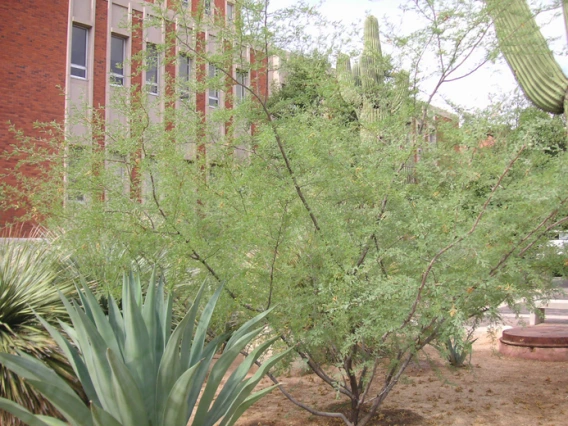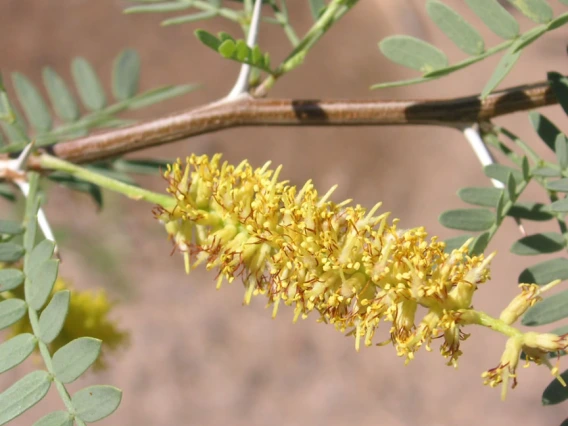


Common Names:
- English: Screwbean Mesquite
- Spanish: Tornillo
- O’odham: Kuujul
Family: Fabaceae (pea/legume family) | Synonyms: Leguminosae
Botanical Name: Prosopis pubescens
Rain Garden Zone: P. pubescens thrives in the terrace Rain Garden Zone. It can also grow well in the bottom Rain Garden Zone, provided that the trunk is not subjected to prolonged periods of standing water. The bottom zone is typically the bottom of a basin or swale. This location is prone to temporary pooling of water as well as nighttime cool air pockets. The terrace zone is typically atop a terrace or on the bank of a basin or swale. These sites have more shallow, less-frequent, and more temporary pooling than in bottom zone.

Reproduced with permission from "Rainwater Harvesting for Drylands and Beyond" by Brad Lancaster, HarvestingRainwater.com
Flowering Season: May—August
Harvest Season (Pods):
- Low Desert: May—June, October—November
- High Desert: June—August, November—January
Harvest Techniques: Harvest mesquite pods before the summer rains. Pods should be picked from the tree rather than from the ground, and pods from particular trees should be taste-tested first for desired characteristics.
Planting Season: Monsoon
Landscape Cultivation: Mesquite should be planted in terrace and bottom rain garden zones. To break through the hard seed coat of the screwbean mesquite, pour boiling water over the seed before planting. Avoid placing trees where the trunk will experience prolonged (>12 hours) standing water.
Characteristics: The screwbean mesquite gets its name from its pods, which have a distinctive coiled shape. P. pubescens is considered a tree or large shrub as it has multiple trunks and can grow to a height of 20 feet (6 m). The bark is light brown and shaggy in appearance due to the separation of fibrous strips of bark.
Ecological Benefits: P. pubescens is a hub for pollinators. Wildlife take advantage of the pods for food, and forests of mesquite that grow along desert rivers provide habitats for birds and mammals.
Practical Uses:
- Food - screwbean mesquite, as well as other varieties of mesquite, is highly valuable as a food source due to the abundance and reliability of pods produced, and the high nutritional content. Almost all species of Prosopis, and other members of the legume family, produce pods that are a key food source for indigenous people for thousands of years. Members of the bean family are able to fix nitrogen in the soil, which provides a source of nitrogen that is incorporated into proteins in the fruit. Mesquite pods are a great source of protein, calcium, magnesium, dietary fiber, iron, and zinc. Beans are ready to harvest during the summer monsoon season, and into the autumn and winter in some regions. After harvest, mesquite pods are dried and ground into a flour to be moistened with water and formed into cakes. Additionally, mesquite pods can be cooked down into a broth or a syrup to release a sweet flavor which can be used in food and drink.
- Domestic Animals - Ground mesquite pods can be used as chicken, goat, and cattle feed. Pods can be ground and made into dog biscuits. Honey bees feed on the nectar of mesquite, pollinate them, and produce honey with a distinct flavor.
- Other Uses - Screwbean mesquite is valued for its domestic uses beyond food—it has been traditionally used for weaving/basketmaking, medicine, shelter, wood/timber, and as a windbreak.
References:
- Desert Harvesters. (2018). Eat mesquite and more: a cookbook for Sonoran desert foods and living. Tucson, AZ. RainSource Press.
- Hodgson, W. C. (2001). Food plants of the Sonoran desert. Tucson, AZ. University of Arizona Press.
- Lancaster, B. (2019) Rainwater harvesting for drylands and beyond, 3rd edition. Tucson, AZ. RainSource Press.
- Little, E. L. (1980). The Audubon Society field guide to North American trees, western region. Alfred A. Knopf.
For more information on this plant, see the Campus Arboretum species description pages.
Go to the next tour stop: foothills paloverde page or Return to the main Dunbar Spring tour page

